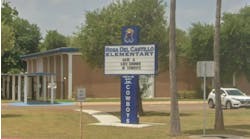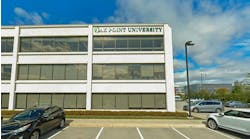At Brown University, Providence, R.I., the campus' unsightly “Dumpster Alley” service area was converted into a swath of beautiful green space. At another institution, plans were developed to expand the university's underused underground tunnels and use electric carts in them to move supplies and utilities among various campus buildings. Another university used natural topography and hillside sites to camouflage services, opening up more green space for students and foliage.
Across the nation, colleges and universities are embracing materials-management planning, a creative and comprehensive solution to managing operations and support services. On many campuses, the receiving, delivery, storage, and removal of supplies and materials consumes a vast amount of space. As institutions expand, the amount of space devoted to infrastructure and support grows rapidly. The unintended result of this expansion: a cluttered, noisy and often inefficient campus. Delivery trucks compete with pedestrians; loading docks are in plain sight; trash containers sprout up; and lobbies, hallways and stairwells are used for storage space.
To better manage support space, colleges and universities are embracing the concept of “the invisible campus.” With a strategic materials-management plan, an institution's service infrastructure can be turned into a virtually invisible and sustainable environment, and a college or university can reclaim valuable campus real estate.
Why “the invisible campus?”
An effective materials-management plan finds innovative and effective ways to take the unattractive and unintended effects of managing operations and support services (delivery-truck traffic, loading docks, storage facilities, materials distribution, recycling and waste removal) and puts them largely out of sight. The goal is to consolidate and efficiently manage core services to create truck-delivery and service-vehicle routes that reduce vehicle or pedestrian conflicts; loading docks and delivery sites that reduce redundancy and increase effectiveness; solid and hazardous waste removal, storage and recycling that reduces cost; and utility infrastructure and service equipment relocation that improves campus aesthetics.
A materials-management plan often is provided as part of a capital-development or master-planning project. Quite often, the plan will make better use of underground or other off-site locations for services in the design of new or renovated facilities.
For example, one university built a new laboratory to replace an existing building that contained central support functions for the entire campus: truck deliveries, mail delivery, waste management and material storage. A materials-management plan was put in place that included mapping numerous underground tunnels and modifying them to place much of the university's support infrastructure below grade. A new underground service center was situated in the multi-story service complex beneath the new facility. By taking an asset the school already had, operations and support services were organized in a more beneficial and productive way.
Better campus circulation
One of the keys to a successful materials-management plan is documenting and understanding all facets of the problem. Doing so means using a full spectrum of experts — architects, planners, traffic, environmental, solid waste, and civil engineers — who work together to ensure every challenge is addressed. Inefficiency and campus image problems can drag down even the most successful capital-expansion or master-planning project, so careful materials-management planning is a must to ensure these projects are successful.
At Brown University, the “Dumpster Alley” area was redesigned with grass, trees and benches. The improvement helped change the flow of student traffic, providing a central path between the two sections of the Brown campus. But just as important, it gave students, faculty, staff and visitors more public space.
Brown University's plan also included developing a better campus circulation infrastructure, another effective way in which educational institutions can achieve “the invisible campus.” Campus service points at Brown were clustered to reduce the number of loading docks and truck parking, thus reducing redundancy and increasing effectiveness.
Harvard University, Cambridge, Mass., brought about better campus circulation infrastructure during the institution's ongoing Northwest Corner project, the most significant new addition to the law school campus in nearly 125 years. The materials-management plan involved resolving an “island” approach to shipping, receiving and vehicle movement, as each building on the campus had developed its own system for vendors, logistics and delivery.
The solution included designing a new central loading facility to meet campus needs, as well as consolidating service areas and docks from three separate buildings into one.
Developing better campus circulation infrastructure also can mean re-evaluating truck delivery and service-vehicle routes. At Harvard, vehicle type, size and schedule were studied to make these more compatible with the surrounding neighborhood. Other institutions transform their campuses by reducing truck traffic, creating a safer environment for pedestrians and a more attractive environment for nearby retail and student use.
Re-evaluating solid and hazardous waste removal, storage and recycling is another way education institutions can achieve “the invisible campus.” This can reduce cost and make the campus more environmentally friendly.
At the University of Pennsylvania, Philadelphia, a materials-management plan included efficient waste-management guidelines and increased recycling initiatives, which was done in part with the building of the institution's new Annenberg Public Policy Center.
Myriad benefits
Education institutions can reap the benefits from effective materials-management plans. For starters, institutions accrue long-term cost savings, as consolidating, reconfiguring and managing a campus' core infrastructure reduces annual operating costs.
Institutions also will get the most efficient use of campus real estate. Green roofs can be created above service facilities to emphasize natural topography, and service spaces can be reconfigured to support safe pedestrian environments, including new pathways and courtyards. Overall, a plan can increase green space on campus greatly.
An effective materials-management plan also means a more holistic approach to managing vehicle use and emissions, solid waste, hazardous waste, recycling and utility services. As a result, this means a greener, more sustainable environment, a reduction in that institution's carbon footprint, and a manifestation of the many demands today for institutions to become environmentally friendly.
And finally, an effective materials-management plan can improve campus aesthetics. Removing unsafe and unsightly conditions, placing core services out of sight, and creating a more pedestrian-friendly campus will improve the visual and physical sense of place for students, faculty, staff and visitors. This can help improve the quality of life for students, and be used as a valuable tool in both recruitment and retention.
Brandon, AIA, is principal architect/planner at S E A Consultants Inc., a Cambridge, Mass.-based engineering and architectural firm. Spruch, PE, is director of higher education services at the firm.



